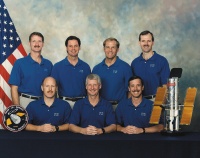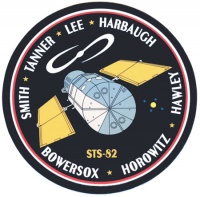STS-82
From The Space Library
 | |
| Organization | NASA-Office of Space Flight (United States) |
|---|---|
| Mission type | Astronomy,Human Crew |
| Launch date | February 11, 1997 |
| Launch vehicle | Space Shuttle |
| Launch site | Cape Canaveral, United States |
| COSPAR ID | 1997-004A |
| Inclination | 28.45 degrees |
| Experiments | Here |
| Alternate Names | OV 103,24719 |
| Additional Information | Here |
| PDMP Information | Here |
| Telecommunications Information | Here |
| Data Collection | Here |
| Payload Mass Up | 7590.86 kg |
| Payload Mass Down | 7467.73 kg |
| Orbiter | Discovery |
| Lift Off Mass | 2,052,054.55 kg |
| Orbiter Weight at Liftoff | 114,259.55 kg |
| Orbiter Weight at Landing | 97,279.09 kg |
| Landed | Concrete runway 15 at Kennedy Space Center, Fla. |
| Orbits of Earth | 150 |
| Orbital Altitude | 320 nautical miles (369 statute miles) |
Contents |
[edit] Crew
- Commander: Kenneth D. Bowersox
- Pilot: Scott J. "Doc" Horowitz
- Payload Commander:
- Mission Specialist 1: Mark C. Lee
- Mission Specialist 2: Gregory J. Harbaugh
- Mission Specialist 3: Steven L. Smith
- Mission Specialist 4: Joseph R. Tanner
- Mission Specialist 5: Steven A. Hawley
- Payload Specialist 1:
- Payload Specialist 2:
ISS/Mir Crew Transport
[edit] Mission
STS 82 was the 22nd flight of the Discovery orbiter, the 82nd shuttle mission, and the 16th night launch of the shuttle. Its objective was to repair, replace, and/or update the instruments on the Hubble Space Telescope. During several days of EVA, the crew replaced a failed Fine Guidance Sensor (FGS), swapped one of the reel-to-reel tape recorders with a solid-state recorder, and exchanged two of the original instruments, the Goddard High-Resolution Spectrograph (GHRS) and the Faint Object Spectrograph (FOS), with two new instruments, the Space Telescope Imaging Spectrograph (STIS) and the Near Infrared Camera and Multi-Object Spectrometer (NICMOS). In addition to this planned work, astronauts discovered that some of the insulation around the light shield portion of the telescope had degraded and attached several thermal insulation blankets to correct the problem. The duration of the mission was 9 days, 23 hours, 38 minutes, and 9 seconds and lasted for 149 orbits.
[edit] EVA
Extravehicular Activity (EVA) conducted by Mark Lee, Steven Smith, Gregory Harbaugh, and Joseph Tanner during five spacewalks for a total of 33 hours, 11 minutes. EVA 1, Lee and Smith, 6 hours, 42 minutes; Lee and Smith removed and replaced the Goddard high-resolution spectrograph and the faint-object spectrograph with the new space telescope imaging spectrograph and the near-infrared camera and multi-object spectrometer, respectively. EVA 2, Harbaugh and Tanner, 7 hours, 27 minutes; Harbaugh and Tanner replaced a degraded fine guidance sensor and a failed engineering and science tape recorder with new spares. They also installed a new unit known as the optical control electronics enhancement kit. EVA 3, Lee and Smith, 7 hours, 11 minutes; Lee and Smith removed and replaced a data interface unit and replaced an old reel-to-reel engineering and science tape recorder with a new digital solid-state recorder. They also changed out one of Hubble's four reaction wheel assembly units. EVA 4, Harbaugh and Tanner, 6 hours, 34 minutes; Harbaugh and Tanner replaced a solar array drive electronics package and covers over Hubble's magnetometers. They then placed thermal blankets of multilayer material over two areas of degraded insulation around the light shield portion of the telescope just below the top of the astronomical observatory. EVA 5, Lee and Smith, 5 hours, 17 minutes; Lee and Smith attached several thermal insulation blankets to three equipment compartments at the top of the support systems module section of Hubble. The compartments contain key data processing, electronics and scientific instrument telemetry packages. Over the course of the mission, Hubble was also reboosted into an orbit approximately 8 nautical miles higher.
[edit] Payload
Hubble Space Telescope Servicing Mission 02 (second axial carrier, orbital replacement unit carrier, flight support system); Midcourse Space Experiment
[edit] Books about the Space Shuttle Program
Buy This Book Click here |
Buy This Book here |
Buy This Book Click here |
Buy This Book Click here |





